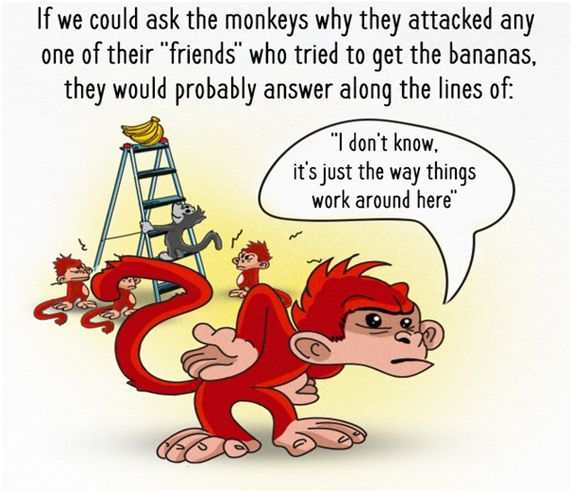Recently in a webinar that I attended; I came across an interesting debate on "how to groom your Low Performing High Potential employees". A lot of interesting points came out by the presenter and the participants. The complete focus was on the potential vs performance of the employees. Each of them was debating on both sides. But what most of them failed to see or speak, was the foundation on which either of these components lounges and nourish.
If we focus on the performance or the potential, we are missing the whole point. Instead, if we move our focus to the culture prevalent, the answers simply recline there.
Steve Jobs said - “It doesn’t make sense to hire smart people and tell them what to do; we hire smart people, so they can tell us what to do. “
Lee Iacocca said - “I hire smart people & get out of their way.”
Let me present this with a story!
Whenever one of the monkeys tried to climb and reach for the bananas, all the monkeys were sprayed with freezing cold water, until they gave up and got down.
A few attempts later, all the monkeys clearly understood that reaching for the bananas is a futile attempt. And therefore, no monkeys ever attempted to reach the bananas anymore & hence the water was never used again.
The experiment continues by replacing of one of the five monkeys with a new monkey. The new monkey, not aware of the icy water spray, tries to climb the ladder for the bananas. Immediately, the other four monkeys attack him repeatedly, until he no longer attempts to reach for the bananas. Remember, this is even before the icy water is sprayed.
One by one, the monkeys which had experienced the original icy water spray were replaced by a new monkey. With the introduction of each new monkey, the other monkeys would attack him until he quit trying to reach the bananas.
Finally, the cage is populated by new group of monkeys & not one of them now have had the experience of the icy water spray. At this point, a 6th new monkey is introduced to the cage. When this monkey tries to climb for the bananas, all five monkeys immediately attack him, even though none of these monkeys have ever experienced collective punishment of icy water, they did so simply because they knew reaching for the bananas is forbidden for reasons unknown.
What can you now relate this story to? I am sure you already fathomed what I am trying to present.
The answer is CULTURE. The most important thing about organizational culture is that it’s the only sustainable point of difference for any organization. Anyone can copy your strategy, but nobody can copy the culture you have built over time. Leaders need to have bigger purpose beyond profit and connecting your employees to that purpose is an important way of helping them feel good about their role and the company.
A great culture cannot be designed or executed in a week month or a quarter. It needs to be a conscious choice by the founders and leaders from the inception. All music is made of the same 12 notes. All culture is made of the same 5 components. Behaviours, relationships, attitudes, values, and environment. It’s all in the way these notes and components are put together which makes a beautiful song.
Culture is created over time - stories, practices & habits are instilled and repeated, rewarded or penalised to make this culture stronger. We hired incredibly talented candidates from great organizations and institutions, but however their performance was very limited because of the existing culture.
Now let’s continue the story further which is my extension to the experiment.
Now assume that each of the 5 monkeys which had experienced the icy water treatment were now introduced into 5 other cages, full of monkeys with bananas hung above the step ladder & no punishment at all.
In a short time, it was seen that the monkeys which had gone through the icy water punishment were outperforming the existing monkeys in other cages by grabbing the bananas faster. Which in my comparison, the people who leave organizations with negative culture & join a better organization, do extremely well. What does this mean? Were they power hungry or was it the accumulated energy and knowledge that they were not allowed to be used in their earlier role?
A typical case of High Potential; Low performance, clearly because of the culture
- The strategy path defines what needs to be done - The culture path emphasizes how things are normally done.
- Strategy drives focus and direction - Culture is the emotional, organic habitat in which a company’s strategy lives or dies.
- Strategy is the headline on the company’s story - Culture needs a clearly understood common language to embrace and tell the story that includes mission, vision, values, and clear expectations.
- Strategy is about intent and ingenuity - Culture determines and measures desire, engagement, and execution.
- Strategy lays down the rules for playing the game - Culture fuels the spirit for how the game will be played.
- Strategy is imperative for differentiation - Culture delivers the strategic advantage.



